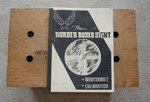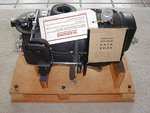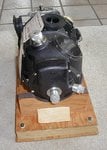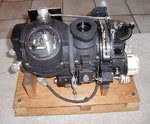Navigation
Install the app
How to install the app on iOS
Follow along with the video below to see how to install our site as a web app on your home screen.
Note: This feature may not be available in some browsers.
More options
You are using an out of date browser. It may not display this or other websites correctly.
You should upgrade or use an alternative browser.
You should upgrade or use an alternative browser.
Norden Bombsight
- Thread starter billrunnels
- Start date
Ad: This forum contains affiliate links to products on Amazon and eBay. More information in Terms and rules
More options
Who Replied?- Thread starter
- #22
great shots of the bombsight head.Here are some shots of a Norden Bombsight. A friend of a friend of mine bought one back in 2013.
Hansie Bloeckmann
Senior Airman
If it cost $10K to produce the Norden in 1940, how were they distributed in a squadron of B-17's. Did each aircraft carry a Norden, or did the USAAF equip just the lead aircraft with a Norden, figuring that the rest of the squadron would drop their bomb load in a "follow-the-leader" scenario?
- Thread starter
- #24
In the beginning each B-17 had a Norden, in fact all of the aircraft our crew used on missions in 1945 still had one. However later in the war(1944- ?) they started dropping on the lead and many aircraft did not have a bombsight. In addition to the war zone aircraft, each Bombardier School AT-11 had one as well as classrooms.If it cost $10K to produce the Norden in 1940, how were they distributed in a squadron of B-17's. Did each aircraft carry a Norden, or did the USAAF equip just the lead aircraft with a Norden, figuring that the rest of the squadron would drop their bomb load in a "follow-the-leader" scenario?
Last edited:
MIflyer
Captain
The Nordens were taken out of the Doolittle Raid B-25's and replaced with a simple protractor and gunsight type of device made out of bent aluminum. At the altitudes they were flying the Norden was of no use.
My high school math and mechanical drawing teacher was a bomb/nav on the Doolittle mission from the USS Hornet. After the war he reproduced a copy of the bombsight for a museum.
My high school math and mechanical drawing teacher was a bomb/nav on the Doolittle mission from the USS Hornet. After the war he reproduced a copy of the bombsight for a museum.
daveT
Senior Airman
I believe that many Norton Bomb sights are still around. Many Air Museums have one and many are in private collections. I have read that they were compromised early in the war and the Germans had copies of them. The Germans used medium bombing and had no use for them. There really was no need for such procedures to ensure they were kept secret.
wuzak
Captain
The Nordens were taken out of the Doolittle Raid B-25's and replaced with a simple protractor and gunsight type of device made out of bent aluminum. At the altitudes they were flying the Norden was of no use.
My high school math and mechanical drawing teacher was a bomb/nav on the Doolittle mission from the USS Hornet. After the war he reproduced a copy of the bombsight for a museum.
I thought that the Nordens were reserved for the heavy bombers.
Maybe that was later in the war?
wuzak
Captain
In the beginning each B-17 had a Norden, in fact all of the aircraft our crew used on missions in 1945 still had one. However later in the war(1944- ?) they started dropping on the lead and many aircraft did not have a bombsight. In addition to the war zone aircraft, each Bombardier School AT-11 had one as well as classrooms.
I believe dropping on the lead began in 1942 or 1943, after initial raids gave the 8th AF enough experience to change their methods.
In any case, a formation would still need several aircraft with the bomb sight, in case the lead bombers were shot down.
I thought that the Nordens were reserved for the heavy bombers.
Initially they were reserved for the Navy (the Mk XV). It was only in July 1931, as an indirect result of federal regulations on open bidding for military procurement, that the Army Air Corps was even aware that such a sight existed.
As war approached the USN had spent twenty years figuring out three methods for sinking ships (dive bombing, level bombing and torpedo bombing)and wasn't about to give up on any of them. This caused the Navy to hold on to thousands of Norden sights when the Air Corps had a critical need for them.
They say Americans don't get irony, but the irony of the USN failing to use the Norden sight, developed by it at great expense, in WW2 must be obvious, though maybe not to the Army, which did use the sight, but had to subordinate its needs for the device to those of the Navy for more than a decade.
It's quite a story, and sometimes it makes you wonder whether the two services were serving the same country!
Cheers
Steve
MIflyer
Captain
One thing I wonder about is the role of Bombardiers and navigators and where they intersected. With the B-25 they had a bomb/nav, one man that did both jobs from his position in the nose. With the Martin B-26 in Europe they had both a bombardier and a navigator, with separate positions, although soon after takeoff it seems that the Nav went down to the nose and argued with the Bombardier over where they were, since both were trained both as navigators and bombardiers. Heavy bombers like the B-17 and B-24 seemed to have separate people in those positions, too.
By the way the Martin B-26 had the Norden bombsight, but in order for the bombardier to use the nose gun the bombsight had to be removed. I read of one mission where they were told to bomb an enemy troop concentration and then go down and strafe. The bombardier sighted through the Norden, dropped the bombs, and then as they turned around to strafe, removed the Norden and handed it to the Navigator, who held the bombsight while the Bombardier gleefully went to work with the .50 cal nose gun and the pilot strafed with the 4 package guns.
So how did they decide when they had a Bomb/Nav or separate positions?
By the way the Martin B-26 had the Norden bombsight, but in order for the bombardier to use the nose gun the bombsight had to be removed. I read of one mission where they were told to bomb an enemy troop concentration and then go down and strafe. The bombardier sighted through the Norden, dropped the bombs, and then as they turned around to strafe, removed the Norden and handed it to the Navigator, who held the bombsight while the Bombardier gleefully went to work with the .50 cal nose gun and the pilot strafed with the 4 package guns.
So how did they decide when they had a Bomb/Nav or separate positions?
That Norden could not do miracles is exemplified by this photo, taken from a bomber attacking Cagliari, 28th Feb. 1943.
Target was the harbour, that is clearly seen in the upper right part of the pic.
These bombs are going to miss of more than one mile, exploding in the open sea at the left.
Clear sky, less than a dozen fighters of the 51° Stormo to harass the bombers, very low AA activity.
Tim Moore
Airman
How do you know they are going to miss? Look at the direction of several of the smoke columns in the picture. The Norden bombsight was designed to position the aircraft and release the bombs upwind of the target. Also, look at the lowest bombs in the picture, and you can see them being carried downwind towards the target.
Certainly the bombs nearest to the camera are going to miss. They are more or less on the vertical of the coast, the attack is vectored from NW to SE and the nearest land on that direction is Tunisia.
From the sun shadows on the bombs this was the second attack of the day, late afternoon.
Another attack on the same target, 31/3/1943.
Of course I didn't say that all the bombs are going to miss.

From the sun shadows on the bombs this was the second attack of the day, late afternoon.
Another attack on the same target, 31/3/1943.
Of course I didn't say that all the bombs are going to miss.
Last edited:
- Thread starter
- #34
I know nothing about B-26 procedures. On the B-17 the bombardier did the bombing and the navigator did the navigation. The navigator had no training on the bomb sight but could toggle the bombs in an emergency. The bombardier was certified in Pilot and DR navigation and could provide navigation assistance in an emergency. We worked as a team on missions.One thing I wonder about is the role of Bombardiers and navigators and where they intersected. With the B-25 they had a bomb/nav, one man that did both jobs from his position in the nose. With the Martin B-26 in Europe they had both a bombardier and a navigator, with separate positions, although soon after takeoff it seems that the Nav went down to the nose and argued with the Bombardier over where they were, since both were trained both as navigators and bombardiers. Heavy bombers like the B-17 and B-24 seemed to have separate people in those positions, too.
By the way the Martin B-26 had the Norden bombsight, but in order for the bombardier to use the nose gun the bombsight had to be removed. I read of one mission where they were told to bomb an enemy troop concentration and then go down and strafe. The bombardier sighted through the Norden, dropped the bombs, and then as they turned around to strafe, removed the Norden and handed it to the Navigator, who held the bombsight while the Bombardier gleefully went to work with the .50 cal nose gun and the pilot strafed with the 4 package guns.
So how did they decide when they had a Bomb/Nav or separate positions?
Harbour of Cagliari, today.
It can be easy observed that the focal point of the release in the previous photo is the center of the main basin, and bombs are spread in a radius of more than one mile.
And this was, in my opinion, an extremely precise bombing, by WWII standards.
To the left there is the industrial harbour, not existing in WWII days.
Btw, I can imagine that my engineer Colleagues did design the Norden bombsigth to drop bombs upwind, and not downwind.... and in that photo the wind was very low, looking at the waves on the coast.
Last edited:
- Thread starter
- #36
A number of factors were considered when choosing the heading for the bomb run, flak concentration was one.View attachment 481772
Harbour of Cagliari, today.
It can be easy observed that the focal point of the release in the previous photo is the center of the main basin, and bombs are spread in a radius of more than one mile.
And this was, in my opinion, an extremely precise bombing, by WWII standards.
To the left there is the industrial harbour, not existing in WWII days.
Btw, I can imagine that my engineers Colleagues did design the Norden bombsigth to drop bombs upwind, and not downwind.... and in that photo the wind was very low, looking at the waves on the coast.
AA was mostly located in the two hills I've highlighted. But of course AA in Cagliari was not exactly equal to Essen.
When I was a lad (late '50) there were still one or two rusted cannons I use to play with in the upper one, as my Grandmother lived at the foot of the hill.

When I was a lad (late '50) there were still one or two rusted cannons I use to play with in the upper one, as my Grandmother lived at the foot of the hill.
Tim Moore
Airman
What I am stating is that you cannot make a determination based on a picture of a bomb after it has just been released as to where it will strike. You cannot know where the bomb will strike without knowing the trail value and the crosswind component and its resultant drift correction. The bomb will always land downwind of the point of release, the crosstrail distance. It will always travel forward of the point of release due to the velocity imparted to it by the plane. It will always land behind the airplane at the time of impact, the trail distance, due to forward and upward wind resistance. You cannot state based on a picture of bombs just released whether all, some, or none will strike the target without knowing those values. I have attached a picture with a description of these functions. I have also restored and operated dozens of Norden bombsights over the years and have attached a video with a visual demonstration of the solution of the bombing problem at the beginning.

View: https://youtu.be/D8IxBv494jk
View: https://youtu.be/D8IxBv494jk
I simply cannot understand how a bomb released from a plane wich is travelling at a f.l. of say 15000 ft and at 300 mph in the direction of the arrow could hit the target identified by the red circle. Those bombs will go undoubtely in the sea.
Surely my fault, laws of kinematics and dynamics of motion that I studied in the University years ago here in the old Europe are probably different than those that apply in U.S...
Last edited:
Tim Moore
Airman
Carl Norden, born Dutch but who lived in Switzerland, was old Europe and he invented the Norden bombsight using those laws.
Perhaps this video clip could help you understand:
View: https://youtu.be/CTPD3lzqYAI
Perhaps this video clip could help you understand:
View: https://youtu.be/CTPD3lzqYAI
Last edited:
Users who are viewing this thread
Total: 1 (members: 0, guests: 1)





